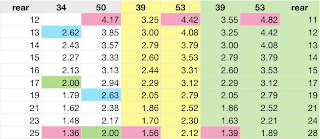Crank
Having started with the bottom bracket, the next piece is what gives the bb it's function. Actually, gives the bike its function. Without a crank the bike becomes a velocipede.Try going uphill without a crank...
And going uphill is possibly the most important consideration when choosing a crank. But what crank?
There are many component manufacturers. Shimano, SRAM and Campagnolo are the obvious giants, but there are also Truvativ, FSA, Ritchie and Raceface to name a few. So it really comes down to a process of elimination.
Campy are out, as I have already decided on Shimano-compatible. I do not like square-taper cranks with external centre bolts. I once had an old tri bike with a Shimano biorythm (?) elliptical chain ring, and without using loctite the centre bolt always came loose after 60 km. After looking at the range of cranksets available, I end up returning to Shimano's Hollowtech system, which boils it all down to 105 or Ultegra.
Standard or compact? I am currently riding a standard (53-39) 105 crank, which last year replaced the original (2007) 105 compact. There is much out there offering tips, eg hills=compact, sprint=standard, but I go by actual ratios. When deciding whether or not to change from compact to standard, I looked at the math.
The first two columns are my old compact combination with a 12-25 cassette. The ratios range from 1.36 up to 4.17. Replacing the crank only shifted the range upwards to 1.36-4.42. I had a ride with some steep climbs, so I swapped out the old (worn) 105 cassette for a new Ultegra 11-28, giving a ratio range of 1.39-4.82.
Comparing this combination with the classic compact combo, the bottom ratio (39-28) is effectively the same as the 34-25, with a steeper top end (4.82) from the 53-11. Simply, the 39-53 standard paired with a 11-28 cassette gives the same bottom end and a taller top end than the normal compact setup.
105 Double 5700 10-speed chainset, 175 mm crank, 39-53 chainrings.
The bargain came from Ribble Cycles in the UK:
http://www.ribblecycles.co.uk/
and cost me the princely sum of
NZ$175.23 (US$137.23)
Pretty much what I am currently using, but I have opted for the slightly longer crank, moving from 172.5 to 175. I am a slow-twitch sort of guy and cannot spin very fast (100rpm is near my limit for any sustained period of time), so if I am to boost my power output need to boost the torque. Physics time! For a force applied about a lever's fulcrum (centre of rotation for a crank),
Torque = force x distance. So, for the same force from my legs if I increase the radius I increase the torque (175 from 172.5 is a 1.4% increase). And really, I'm not going to notice the extra radius in my stroke.
Next, I start finding a pair of pedals...


No comments:
Post a Comment